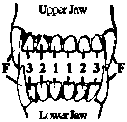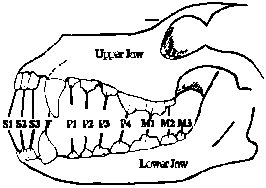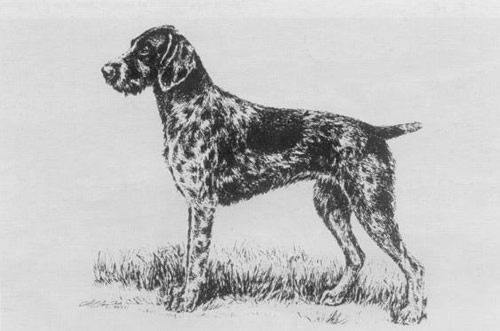Breed Standard
German Wirehaired Pointer)

FCI-Standard Nr. 98/29.11.2000/GB
Deutsch- Drahthaar (German Wirehaired Pointer)
Translation:
Elke Peper
Origin:
Germany
Date of Publication of the originally valid standard:
25.10.2000
Utilization:
According to his purpose of a versatile working gundog the German Wirehaired Pointer must possess all the dispositions asked for the breed. He must be usable for all the work in the field, in the woods and in water before and after the shot.
The Breed Standard - FCI Classification
Classification F.C.I.:
|
| Group 7 |
Pointing Dogs. |
| Section 1.1 |
Section 1.1 Continental Pointing Dogs.
With working trial. |
Brief historical summary:
The Deutsch-Drahthaar is a rough coated pointing dog whose initial breeding started at the end of the 19th century (Griffon Korthals), and that has been systematically bred from the beginning of this century based on the ideas of "Hegewald" (Sigismund Freiherr von Zedlitz and Neukirch) with the sealed aim of creating an assertive; efficient wirehaired German gundog. In accordance with the principle of "by working ability to type" and with consequent regard to freedom of breeding, within a short time a gundog has been developed from the best of the rough coated types (Pudelpointer, Griffon Korthals, German Broken Coated Pointing Dog) and by using the German Shorthaired Pointer, that excels through his useful weatherproof coat and his versatility in all fields of practical hunting. Due to these characteristics, the Deutsch-Drahthaar within a few decades has developed to become the most popular and well-tried among the large gundog breeds in Germany as well as in many countries of the world.
General appearance:
A pointing dog of noble appearance, with harsh coat completely protecting the skin, with an attentive expression full of energy. The movement should be powerful, ground covering, flowing and harmonious.
Important proportions:
The length of the body and the height at the withers should be as equal as possible. The length of the body may exceed the height at the withers by up to 3 cm.
Behaviour/Temperament:
Firm, self-controlled, well-balanced, without shyness of game, neither sensitive when shots are fired nor shy or aggressive.
Head:
In proportion to the size and the sex of the dog. Lines of head slightly diverging.
The Breed Standard - Cranial Region
Cranial region:
|
| Skull: |
flat, slightly rounded at the sides only, moderately broad, pronounced superciliary ridges. |
| Stop: |
Clearly visibly pronounced. |
The Breed Standard - Facial Region
Facial region:
|
| Nose: |
Strongly pigmented corresponding to the colour of the coat.
Nostrils well opened. |
| Muzzle: |
Long, broad, strong, deep. Slight roman nose.
Well pigmented corresponding to the colour of the coat. |
| Lips: |
Thick, close-fitting, not overhanging. |
| Jaws/teeth: |
Large teeth.
Powerful jaws with a regular, complete scissors bite with the upper teeth closely overlapping the lower teeth and set square to the jaws.
42 teeth according to the dentition formula. |
| Eyes: |
As dark as possible, neither too deep-set nor protruding, with an alert, lively expression.
Eye rims well pigmented and close-fitting. |
| Ears: |
Of medium size, set on high and wide, not twisted. |
Neck:
Of medium length, strongly muscled; slightly arched napeline, clean cut throat, no dewlap.
The Breed Standard - Body
| Body: |
| Topline: |
Slightly sloping from the withers in a straight line. |
| Withers: |
Pronounced. |
| Back: |
Firm, well muscled. |
| Loins: |
Short, broad, muscular loin region. |
| Croup: |
Long and broad, slightly sloping and well muscled. Broad pelvis. |
| Chest: |
Broad and deep with well developed forechest, the breastbone reaching as far back as possible. Ribs well arched. |
| Underline and belly: |
Slight tuck-up towards the rear in an elegant curve. |
Tail:
Following the topline, carried as horizontally as possible or slightly raised, but not steep. Neither too thick nor too thin. Docked for the hunting purposes. (In countries where docking is prohobited by law, the tail may be left natural. It should reach the hocks and should be carried straight or slightly sabre-like.)
Limbs:
The Breed Standard - Forequarters
| Forequarters: |
| Forequarters: |
Viewed from the front, straight and parallel, viewed from the side, legs set well under the body. The distance from the elbows to the ground to be approximately equal to the distance from the elbows to the withers. |
| Shoulders: |
Well laid-back, sloping shoulder blade, strongly muscled.
Forming a good angle together with the upper arm. |
| Upper arm: |
As long as possible, with well developed, lean muscles. |
| Elbows: |
Close to the body, neither turning in nor out.
Good angulation between upper arm and forearm. |
| Forearm: |
Lean, set perpendicular, strong bones. |
| Carpal joint: |
Strong. |
| Pasterns: |
Slightly sloping. |
| Front feet: |
Oval-round with well-knit toes and sufficiently thick, tough, robust and well-pigmented pads.
They are set parallel, neither turning in nor out in stance or when moving. |
The Breed Standard - Hindquarters
| Hindquarters: |
| Hindquarters: |
Viewed from behind, straight and parallel.
Well angulated at the stifles and the hocks. Strong bones. |
| Upper thigh: |
Long, broad, muscular, with good angulation between pelvis and upper thigh. |
| Stifle: |
Strong, with good angulation between upper and lower thigh. |
| Lower thigh: |
Long, muscular and sinewy. |
| Hocks: |
Short, perpendicular to the ground. |
| Hind feet: |
Oval-round with well-knit toes and sufficiently thick, tough, robust and well-pigmented pads.
They are set parallel in stance and when moving, turning neither in nor out. |
Gait/Movement:
Covering lots of ground, with good reach and drive, parallel coming and going; with upstanding posture.
Skin:
Tight, close-fitting, without folds.
Coat:
Hair:
Wirehaired harsh, flat lying and dense. Outer coat approximately 2 to 4 cm long; dense, water-resistant undercoat. The outlines of the body may not be obscured by longer coat. Through its harshness and density it should provide as good protection against weather and injuries as possible. The lower parts of the legs, as well as the lower region of the brisket and the belly, should be shorter but densely coated, the head and the ears to be shorter and at the same time denser but never softer coated. Pronounced eyebrows and a well developed not too long, as harsh as possible beard emphasise the determined expression.
Colour:
- Brown roan with or without patches.
- Black roan, with or without patches.
- Brown with or without white chest patch.
- Light roan.
No other colour is permitted.
The Breed Standard - Size Region
| Size: |
| Height at withers: |
Dogs: 61 to 68 cm
Bitches: 57 to 64 cm |
Faults:
Any departure of the foregoing points must be considered a fault and the seriousness with which the fault should be regarded should be in exact proportion to its degree.
Severe faults:
- Short or narrow or pointed muzzle.
- Weak dentition.
- Very loose eyelids.
- Swayback or roach back.
- Heavily overbuilt.
- Elbows heavily turning in or out.
- Bandy-legged, cow hocked or close behind, in stance as well as in movement.
- Pacing permanently when stepping or trotting, stiff or mincing gait.
- Sparse coat, lacking undercoat.
Eliminating faults:
- Any kind of weak temperament, especially gun or game shyness, aggressiveness, nervousness, fear biter.
- Over-or undershot bite, wry mouth, missing teeth other than P1.
- Entropion, ectropion, differently coloured eyes.
- Innate kinky or stumpy tail.
- Faulty pigment.
N.B.
Male animals must have two apparently normally developed testicles fully descended into the scrotum.
Explanatory Comments on Deutsch-Drahthaar Standard
The Standard describe the ideal conformation of the Deutsch-Drahthaar (DD). The breeding goal under these standard is to produce a mentally stable, well-performing, noble, medium large but strong pointing dog whose harmonious and purposeful conformation and hard coat, providing full protection of the skin, enable him to meet into his old age all the demands posed by versatile hunting activities.
When evaluating a dog, the degree to which he deviates in certain categories from the ideal conformation shall be taken into proper consideration for the final judgment. To this end, the VDD generated an evaluation form defining those evaluation criteria, which take into account the categories to be evaluated under the guidelines of the Breeding Regulations. These evaluation forms shall be used at Breed Shows organized by the VDD.
Whereas the Standard submitted to the FCI describes the DD in comparison to all other dog breeds, including non-pointing and non-hunting breeds, the VDD breeding evaluation from (Conformation and Coat Evaluation Form) contains VDD specific terms which apply only to the DD breed. In this regard, VDD and FCI language do not concur.
Depending on the degree of the variation from the breed typical features, Faults shall be classified as follows:
- Breeding Prohibiting Faults
- Severe Faults
- Faults
- Imperfections and Beauty Faults
All Breeding Prohibiting Faults and Severe Faults are listed below, with Faults and Beauty Faults listed as examples:
Dogs with good mental disposition, typical features, and very good movement shall be placed above all others during the evaluation.
- Breeding Prohibiting Faults are listed both in the Breeding Regulations and the Standard. The display of anyone of the listed Breeding Prohibiting Faults shall result in the evaluation of "Disqualified" (Disq).
The Breed Standard - Breeding Prohibiting Faults
| Breeding Prohibiting Faults |
Breeding Prohibiting Faults:
- gun sensitive
- game shy
- mental instability (e.g. aggressive, nervous, fear biter)
- ectropian or entropian
- differing eye color, glass eye
- genital abnormalities (missing or abnormal testicles)
- color irregularities: black (including with breast patch), white or yellow dogs or yellow roan
|
- over-, under- or crossbite
- narrow based fang teeth
- missing teeth other than P1
- light nose color
- inherited stub or crooked tail
|
- Severe Faults are serious deviations from the breed typical features of the DD. These shall also include faults, which may substantially impair the performance and workability of the dog. Dogs with anyone of the Severe Faults shall be evaluated at most with "Sufficient" (Ggd).
The Breed Standard - Severe Faults
| Severe Faults |
Severe Faults:
- restless, frightened or similar mental faults
- over or under the dimensional Standard
- opposite sex type
- very short, very narrow or pointed muzzle
- weak bite
- open eyelids
- sagging or roach back
- heavily overbuilt
- substantially turned out or in elbows
- heavily cow hocked or barrel legged
|
- insufficient beard
- hair too long, too thin,
too woolly, or open hair
- missing undercoat
- pigmentation irregularities,
e.g. washed-out hair
or ashen (grey)
- continuous Pacing gait
(walk and trot)
|
- Faults are variations from the Standard with less impact on the dog's performance and workability. Dogs with any one of the below listed Faults shall be evaluated at most with "Very Good". (SG).
The Breed Standard - Faults
| Faults |
Faults:
- less distinguished sex type
- short muzzle
- partial plier or plier bite
- light colored eyes
- leather ears
- tucked up loins
|
- little tension
- steep or short croup
- flat breast or ribs not arched
- steep angulation of the limbs
- intermittent pacing
|
- Imperfections/Beauty Faults do not affect the dog's performance and workability. Depending on the degree and the number of these variations present, the dog may still be evaluated with "Excellent" (V).
Beauty Faults are for example:
- somewhat flat stop
- ears too long or too wide
- no eyebrows
Bite and Eyes of the Dog
The Breed Standard - Teeth Positioning
| Teeth Positioning |
 |
 |
 |
 |
Scissors Bite
All incisors of the upper jaw slightly overlap the incisors of the bottom jaw. |
Plier Bite
All incisors of the lower jaw set on top of the incisors of the upper jaw. |
Overbite
All incisors of the lower jaw are in front of the incisors of the upper jaw. |
Underbite
All incisors of the lower jaw are significantly behind the incisors of the upper jaw. |
The Breed Standard - Teeth Positioning Deviations
| Teeth Positioning Deviations |
| Crossbite: |
3 side-by-side incisors of the lower jaw are in front of the incisors of the upper jaw, while the other 3 incisors of the lower jaw correspond to a scissors bite. |
| Partial Plier Bite: |
1 to 5 incisors of the lower jaw are set on top of the incisors of the upper jaw. |
| Partial Overbite: |
1 to 5 incisors of the lower jaw are in front of the incisors of the upper jaw. |
Partial Underbite:
|
1 to 5 incisors of the lower jaw are significantly behind the incisors of the upper jaw. |
The Breed Standard - Eyes
| Eyes |
 |
 |
 |
 |
Correct Eyelids
Eyelids attached. |
Open Eye
Standing off. |
Ectropium
Rolled to the
outside. |
Entropium
Rolled to the
inside. |
Anatomical Drawing of the DD
|
|













